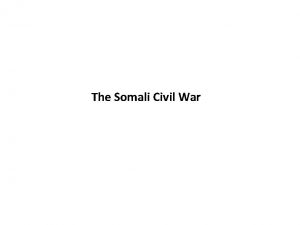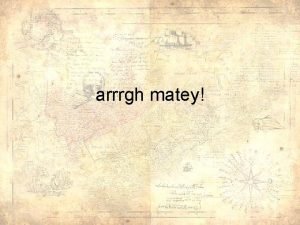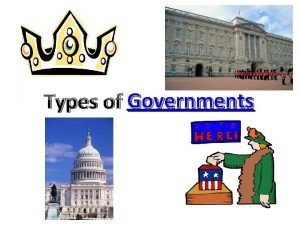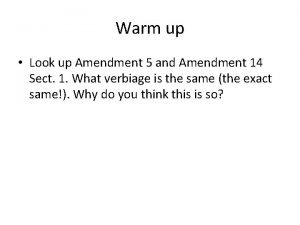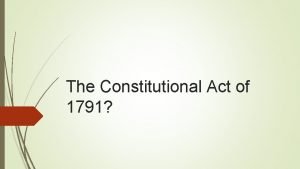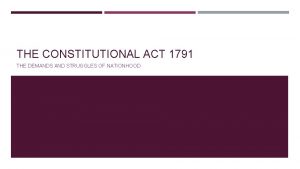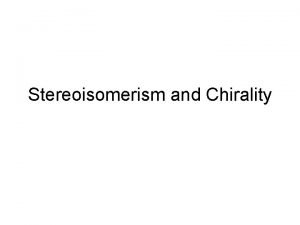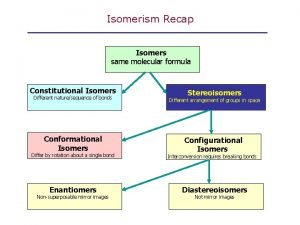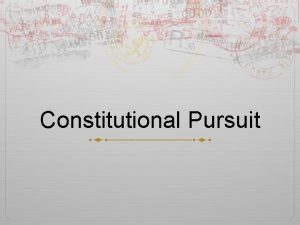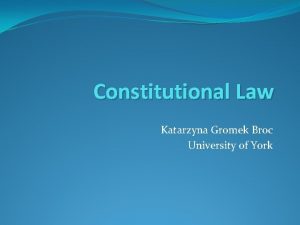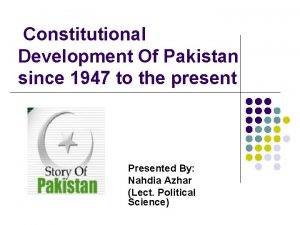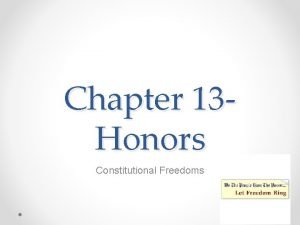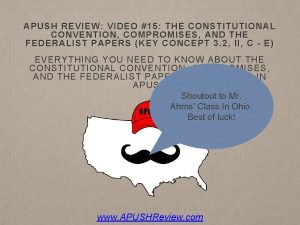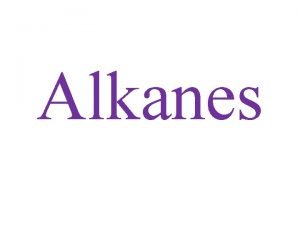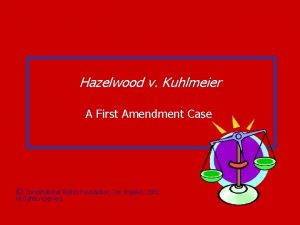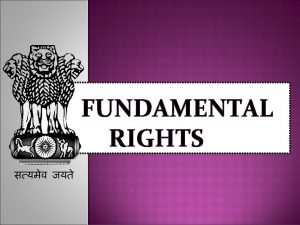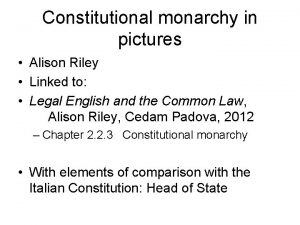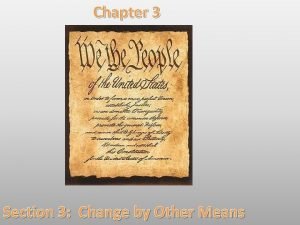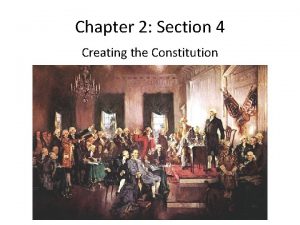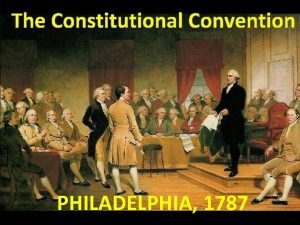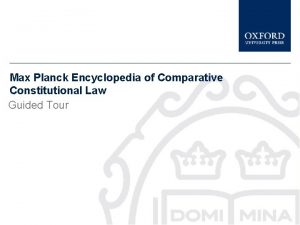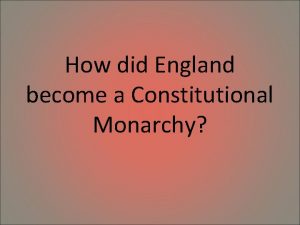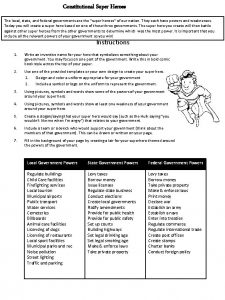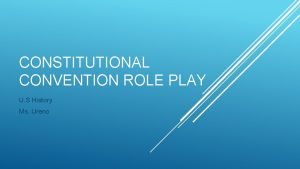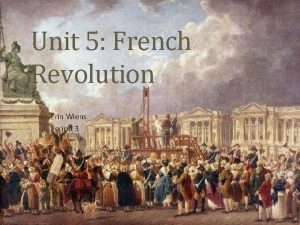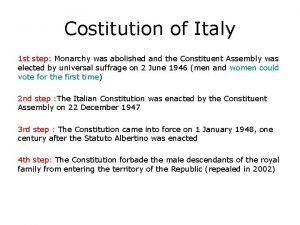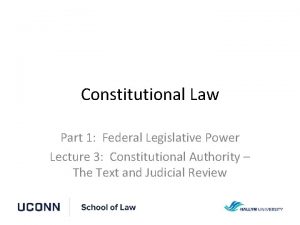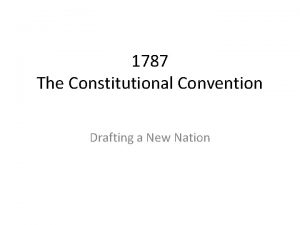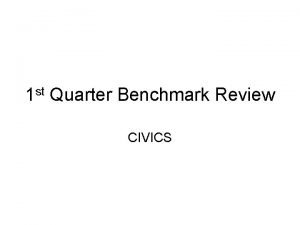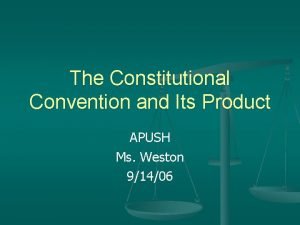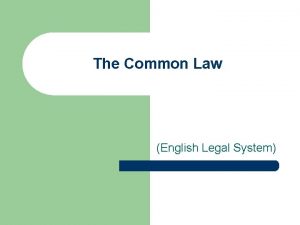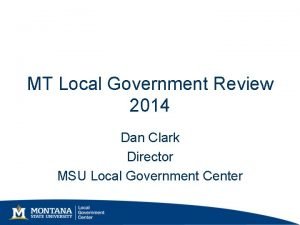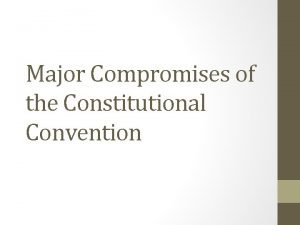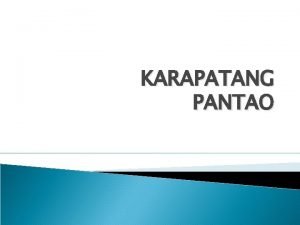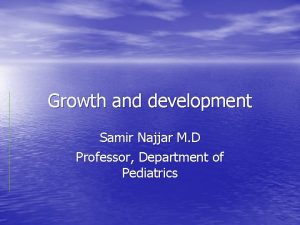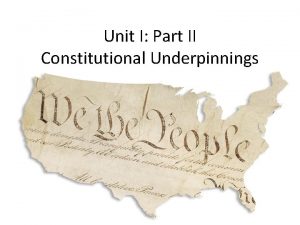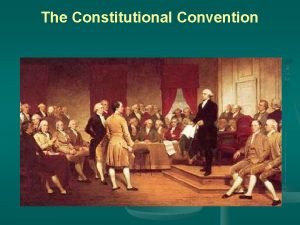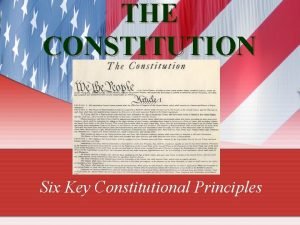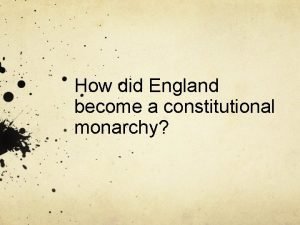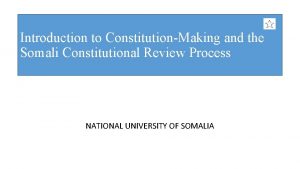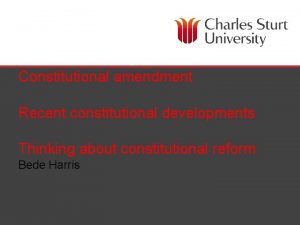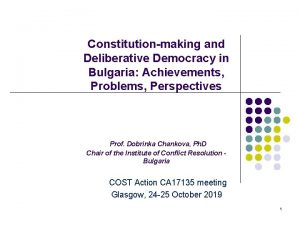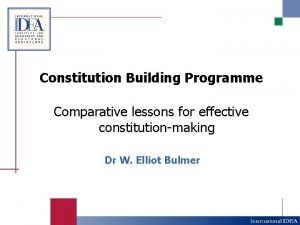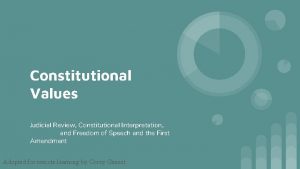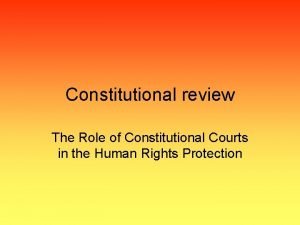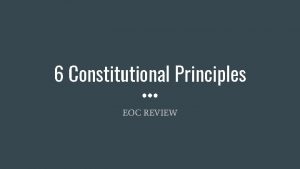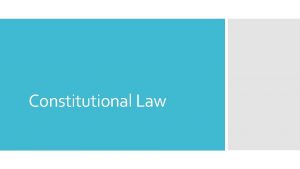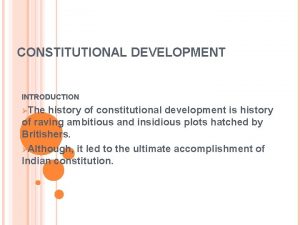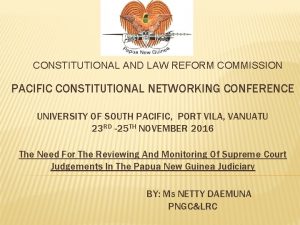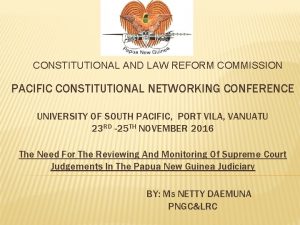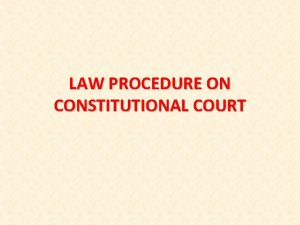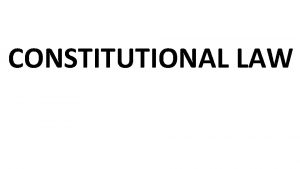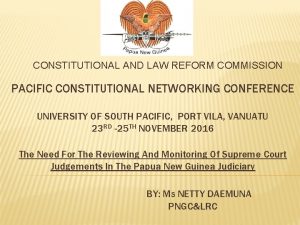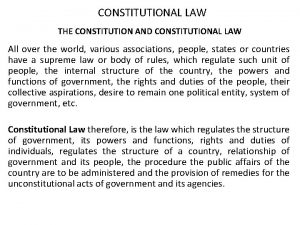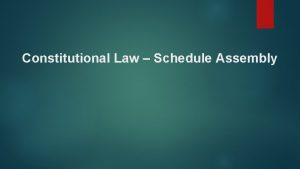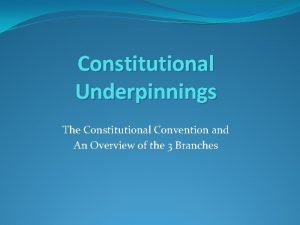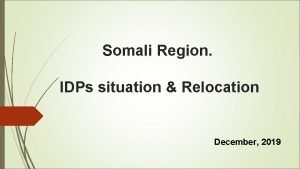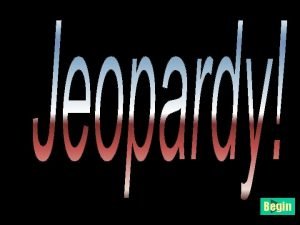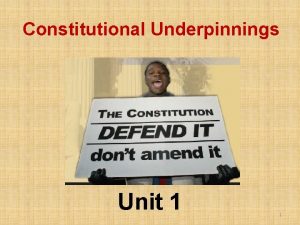Introduction to ConstitutionMaking and the Somali Constitutional Review


























































- Slides: 58

Introduction to Constitution-Making and the Somali Constitutional Review Process NATIONAL UNIVERSITY OF SOMALIA

Presentation Outline • • • Introduction Waves of constitution-making Constituent Power Constitution-making and external influence Constitution-making v amendment Unconstitutional amendments Three common phases in constitution-making processes Constitution-making & Review in Somalia What next? 2

Introduction Characteristics of modern constitutions • Constitutions are different from ordinary law, they are higher law; • As well as having primacy over other norms, they give force and validity to lower sources of law; • A constitution is set to directly emanate from the “will” people; • Constitutions are difficult to amend, often requiring supermajorities and therefore consensus between majority and minority political interest; • Constitutions, especially recent ones, come in written form;

Waves of constitution-making • There have been several waves of constitution making in modern history; • Most recently in the 1990 s and 2000, constitutionmaking has spiked following the collapse of the Cold War and moves towards democratisation;

Constituent Power • The making of a new constitution creates a rapture with the old and often deliberately disregards the rules of constitutional amendment in the constitution to be replaced; • This begs the question: where does the authority to create a new constitution come from? • Legal theory ascribes the constitution-making power to the ‘constituent power’ [also known by its French equivalent ‘pouvoir constituant’] • The constituent power is “the power to establish the constitutional order of a nation” [Roznai 2014];

Cntd • Therefore, any constitution, including one displacing an old one is derived from the will of the people; • However, although the source of constitutionmaking power, the people do not all directly participate in the process from start to finish; • They exercise their constituent power through elected representatives;

Constituent Power in Action: Philadelphia Convention • The decision to convene a constituent assembly was made by the Continental Congress in 1787; • The Continental Congress tasked the delegates with amending the Articles of Confederation, not creating a new constitution; • However, in the end the delegates proposed a new constitution; • By exercising the people’s will - unbound by the old legal order - the delegates’ authority to depart from the Articles was justified on the basis of the necessity to found a new constitutional order*; • As the preamble of the constitution makes it clear, it is “The People of the Unites States” that ordained and established the constitution;

Constitution-making and external influence • Countries with international involvement in their transition or post-conflict rebuilding may find their constitutional reform impacted by external influence; • International involvement can vary from the provision of technical advice, resources to complete administration of the constitution-making process; • Examples • Iraq was under military occupation when the constitutional reform was initiated; • East Timor constitution was adopted During international administration; • The Basic Law of Germany was drafted with the influence of Western Allies;

Iraq • Between 2002 – 2003 Iraq was under the military occupation of the United States and the United Kingdom; • The Coalition Provisional Authority was responsible for its administration; • The CPA established the Iraqi Governing Council (an appointed body) to draft the Law of Administration for the State of Iraq for Transitional Period [TAL]; • TAL includes a legal framework for the constitution-making process incl: 1. 2. Drafting of the permanent constitution by an elected national assembly; Ratification by referendum

Cntd • The main drafting of the substantive content of the constitution took place after the military occupation formally ended (Jan 2005) with elections of a transitional parliament. • Because the Sunnis had largely boycotted elections to the National Assembly additional representation had to be secured in the constitution-making process; • Complaints of external influence remained throughout the process: • The influence of TAL [drafted by the occupying forces] on the permanent constitution was a recurring issue; • Concerns around foreign influence related to both substance, process and timeframe.

Constitution-making v amendment • Constitutions may be adopted with the intention to endure, but other than few notable exceptions (such as the US Constitution), most constitutions have a lifespan of 7 years [ Ginsberg & Mellon 2009]; • Constitutions may be replaced or amended, but sometimes the lines between the two can be blurred; • Amendments follow the procedural and substantive requirements in the existing constitution [legal continuity]; • Replacements are a departure from the existing constitution [rupture].

Cntd • Triggers for constitutional replacements may include: • • Revolutions; Independence following colonialism; Statebuilding/State-creation [Iraq, East Timor, South Sudan] Regime change or defeat in war • Continuity v rupture • South Africa managed to balance the need for legal continuity and the transition away from a delegitimised constitution, parliament and government by using the devise of an interim constitution; • Its interim constitution bridged the old and the new;

Unconstitutional amendments • Constitutions may explicitly prohibit amendments to certain provisions in the supreme law; • Examples include: Venezuela Art. 6 ; Senegal Art. 103; Qatar Art. 104; Iran Art. 177 and Germany Art. 79(3); • In the absence of an explicit constitutional provision, Courts have dealt with the issue unconstitutional amendments; • In Njoya v. Attorney General, the High Court was asked (and dismissed) whether the Kenya constitution empowered Parliament to repeal it and enact a new one in its place;

Cntd • Similarly an earlier decision of the Indian Supreme Court questioned the constitution’s unamendability despite lacking an implicit amendment limitation; • It held that amendments do not “include the power to abrogate or change the identity of the Constitution or its basic features” [Kesavananda Bharati v State of Kerala];

Three common phases in constitution-making processes 1. Setting the agenda; 2. Design, drafting and approval; 3. Implementation [Cheryl Saunder, Constitution-making in the 21 st Centry]

Setting the Agenda

Setting the agenda • At this early stage, one of the most critical decision to influence the process is whether to maintain legal continuity or break with the previous constitution and its rules on constitutional amendment; • Departing from an existing constitution may be necessitated by the prevailing circumstances, but it does raise higher demands for legitimacy for the constitution-making body; • The source of legitimacy for the new constitution is not the old constitution, but the people; • In Columbia the constituent assembly was expected to amend the constitution, but during the task realised that a new constitution was required; • The constituent assembly was allowed to exceed its mandate in part because the process of convening it had high public support and participation;

Constitution-making Starting the process/Setting the agenda • In the event of the collapse of a previous regime or the creation of a new state, a new constitution is sometimes said to come from a vacuum, such as in Timor Leste or post revolution France & US; • In Kenya an act of Parliament triggered the constitutional reform process [Constitution of Kenya Review Act 2008]; • Poland & South Africa both drew their constitution-making framework from political settlement between the government and opposition forces; • Bosnia-Herzegovina is an unusual example of the entire constitution being drafted during international peace agreements and adopted as an annex to the peace agreement

Constitutional Review 1997 Kenya • The Kenya president Moi set in motion a process to review the independence constitution of 1963, which similar to most independence constitution was negotiated in London; • A bill was adopted by Parliament to establish a 29 member Commission charged with reviewing the constitution and proposing amendments to Parliament; • A review Commission chaired by Professor Yash Ghai was established in 2000 to “draft a Bill to alter the Constitution for presentation to the National Assembly”;

Cntd • A National Constitutional Conference was established to deliberate & adopt the draft produced by the Commission; • The National Constitutional Conference was recognised for its inclusivity; • It was composed of 629 members which included the National Assembly, the Review Commission, 41 persons representing a political party and 126 representatives of different communities; • The draft constitution approved by the National Constitutional Conference was meant to be submitted to the National Assembly for “enactment within seven days”;

Cntd • The outcome of the Conference was, howeve, r challenged in the High Court on the basis that the draft amendments was closer to a new constitution (rather than an amendment) and breached the constitutional amendment process; • The court agreed that a new constitution engaged the constituent power and therefore a new constitution required popular referendum; • A referendum was conducted and failed to gather sufficient support for ratification;

Provisional/interim constitutions South Africa • The white-dominated government of South Africa was forced to concede to liberalisation and democratisation after escalating violence and economic collapose; • Talks between the government and opposition, the ANC, among other things centred around the process of creating a new constitution; • The government wanted to be involved in the constitutional reforms and demanded that all amendments be brought into effect by the existing (white) parliament; • The ANC did not recognise their legitimacy and opposed; • A compromise was achieved by putting in place an interim constitution under the first process and the final constitution adopted by an elected, democratic, non-racial parliament/constitutional assembly;

Cntd • The interim constitution was a product of political compromise negotiated between the Apartheid government and opposition under the so-called Multi Party Negotiation Process. It was adopted by the last apartheid-era parliament in 1993; • The interim constitution critically provided: § A framework to govern South Africa until the adoption of the final constitution; § Specified the process for constitution-making; § Embedded 34 constitutional principles the final constitution had to comply with and; § Created a newly established Constitutional Court task with, among other, things certifying the final constitution against the principles;

Cntd Other examples: • In 1993 Malawian voters overwhelmingly approved a return to multiparty politics that resulted in a provisional constitution that in turn called for a National Constitutional Conference to create a permanent constitution. • Tanzania – a provisional constitution was in place after Tanganyika and Zanzibar united. It remained in force between 1965 and 1977 when the final constitution for Tanzania was adopted;

Design

Constitution-making bodies • Countries have adopted a variety of constitutionmaking forums to reflect their constitutional tradition; • One or several institutions may be involved in the process; Legislature alone (Hungary) Constituent Assembly alone Commission/Committee Constituent Assembly Referendum (Somalia) Commission/Committee Constituent Assembly Referendum (Kenya? ) National Conference Legislature National Conference Referendum (structure drawn from p 231 Interpeace) Legislature

Cntd • While there is no one institutional model that fits all circumstances, patterns of constitution-making bodies can be observed based on data from 194 constitution-making/reform processes between 1975 to 2002; Constitution-making body Percentage Pure legislature 36. 6% Pure constitutional assembly 17. 9% Legislature sitting as constituent assembly 5. 7% National conference 3. 1% Roundtable 1. 5%* [Hart, 2010]

1. Regular legislature Substantial Constitutional amendments Hungary: Parliamentary amendment process • Parliament was preferred over a constituent assembly in Hungary due to worry that the communist party would have majority seats if elections for a constituent assembly were conducted; • Constitutional process was characterised by legal continuity rather than rapture i. e an amendment [albeit very significant amendment] of the 1949 constitution; • The negotiations between government and opposition parties, known as the Round Table were critical in informing the process; • Ultimately parliament failed to draft a new constitution [why]

Constituent assembly Tasks • May draft a constitution (and adopt it); • May only deliberate on a constitution drafted by another body (Afganistan’s Loya Jirga);

• Advantages: § Greater legitimacy; § Devote fulltime to constitution-making; § Due to fear of self-dealing sometimes constituent members are prevented from running for parliamentary elections; § Composition can be structured in way to ensure representation; • Sometime constituent assemblies are given the option to convert themselves to a parliament after constitution-making – e. g East Timor, Namibia, Fiji;

2. Legislatures with dual function as constituent assembly South Africa • The first democratic parliamentary election took place in April 1994; • Parliament had a dual role as a constituent assembly [CU] to draft & adopt the constitution; • The CU created a constitutional committee of 44 members representing parties proportionally to negotiate, coordinate and make decisions; • Theme committees worked on different parts of the constitution and took leading role in public consultations; • Additionally a seven member panel of independent constitutional expert was appointed by the CU to advise it [Article 72];

3. Pure constituent assembly Columbia • Popular referendum voted in favour of the establishment of a constituent assembly; • 70 members were directly elected nationally and some seats were reserved for guerilla groups and new electoral rules made it easier for communities to compete with traditional parties. • For the first time, public resources were given to candidates running for the constituent assembly*; • The Constituent assembly created 5 commissions to deal with different topics. Their decision were not binding, but brought to plenary y;

Constitutional commissions/panel of experts • Constitution-making bodies can be supported by Commissions; • Summarising their work as “preparatory”, Murray & Kirkby note that there is usually contention about the composition of Commissions and the weight given to their recommendations; • Murray observes that the issue with Commissions is “whether the appointed members are seen as legitimate by the public”; Examples: • In Tanzania, although the President had discretion to appoint the Commission, civil society pushed to have a say [Murray]; • During the drafting of the Namibian constitution of 1990, a three panel of constitutional experts was recruited from South Africa;

Kenya’s Committee of Experts • Kenya’s draft constitution was rejected by voters in 2005 and restarted in 2008 following peace agreements after the postelection violence; • A Committee of Experts [Co. E] consisting of 9 members (three foreign & 6 national) was appointed by Parliament; • The Co. E were tasked to identify the issues which are contentious or not agreed upon in the constitutional review process before another referendum; • According to Kenyan scholars the Co. E “was interacting with both the people and the parliamentary committee on the constitution”

4. National Conventions • National conventions were heavily used in Francophone Africa in the late 1980 s and early 1990 s to deal with popular calls for liberalisation and democratisation; • Participants in national conventions were, unlike constituent assemblies, unelected; • Described as multi-purpose bodies [Interpeace], they did not always function as constitution-making bodies; • Some Conventions provided transitional legislatures only with guiding principles for the new constitution to adhere to; • Most stipulated that constitutions be ratified by referendum;


Benin National Conference Ratification of Constitution by Referendum Feb 19 -28 1990 December 1990 • In Benin, beleaguered President Kérékou convened a national convention to discuss the country’s future; • 488 people from government, political parties, unions, religious and women’s groups etc participated; • While anticipated to have an advisory role only, the conference declared itself sovereign [IDEA] and dissolved parliament, appointed a transitional legislature and executive and drafted a constitution; • Isolated and under pressure, President Kérékou was forced to accept the national conference’s position [Harris Peter & Ben Riley];

Public participation • The drafting of several celebrated constitutions and constitutional processes have taken place in secrecy and behind close doors [US Constitution; Hungary; Germany]. • Moderns constitution-making processes however place great value on the participation of a wide segment of society; • Not only do constitutions lay out the power map, they are after all, said to be derived from the “people’s will” ; • The legitimacy of the resultant document and potentially its successful implementation, is now widely linked to the role the public is given during the reform process;

Cntd • Public participation may also be deemed further peace, political settlement and constitutionalism in light of the reasons for constitution-making in the first place: • Post-conflict situations; • Democratisation [South Africa, Kenya]; • Public participation may include: • Popular election of the constitution-making body; • Education/consultation and/or; • Referendum;

Cntd • Education/Consultation: South Africa embarked on a comprehensive public consultation and education on the draft of the final constitution although it was not required by the formal constitution-making process (and in contrast to the interim constitution); • Public consultants can, however, be misused for partisan reasons creating division and insecurity; • Zimbabwe provides one of several cautionary examples on the difficulties of undertaking public consultations in a closed political space and climate of intimidation; • During public consultations in Zimbabwe opposition members were intimated, meetings disrupted and members of the drafting committee arrested;

Cntd • Public participation does not end with submission; • The volume of public response can be large and difficult to manage; “Uganda Commission gathered 15, 693 memoranda from the various resistance councils and 25, 547 in total; Kenya’s Committee of Experts (2009) received nearly 40, 000 submissions in the 30 -day period that their draft was submitted for public comment; Ghana’s Constitution Review Commission (2010) received over 70, 000 submissions over the course of its work. ”[Murray & Kirkby] • Constitution-making processes have sought different solutions on capturing and reflecting diverse and large numbers of submissions in the final text;

Adoption

Adoption of constitution Constituent Assembly or Parliament • Constituent Assemblies and parliaments may in addition to drafting and/or deliberating also be empowered to approve the constitution; • In Namibia, a directly elected constituent assembly was entrusted with the entire constitution-making process; • The lack of popular ratification was not considered a problem due to the participation of political parties and the constituent assembly’s strong adherence to pre-agreed constitutional principles; • Similarly in South Africa, the constituent assembly/legislature was responsible for adoption, but the final constitution only took effect once it was “certified” by the Constitutional Court;

Adoption of constitution Referendum • Ratification of a constitution or constitutional amendment by popular referendum is commonly included for new constitutions or significant amendments; • Eligible voters participate in a national vote to approve or refuse; • Crucially, the public votes on the finished product (a simple yes or no vote) which says nothing about the quality of their engagement during drafting;

Cntd • A referendum was only envisaged in Uganda if: 1. 2. the constituent assembly failed to reach a 2/3 on any part of the constitution or; the President called a referendum before promulgation; • In multi-level or devolved systems, the adoption of a draft constitution or amendment may require more stakeholders to endorse changes; • Referendum in specific parts of the country that are affected; • Minimum ratification in specified sub-national units; Example: • As well as a majority nationally, the 2010 referendum on the Kenyan constitution required at least 25% support in five of the eight provinces.

Constitution-making & Review in Somalia

al 201 Con 2 Pro stit visio utio na l n 200 Fed 4 Tra era nsit l Ch ion art al er 200 Cha 0 Tra rte nsit r ion titu tion ons 197 9 C 196 Ref 1 Ind erend Con epend um stit enc utio e n n nio f. U ct o 196 0 A Constitutional History Timeline

1960 Independence Constitution • The first Somali constitution was initiated as part of the process towards self-government for Italian Somaliland under UN Trusteeship at that time; • A technical committee composed of nine Italian members and an expert on constitutional members helped prepare it; • An additional 12 members [including 9 Somalis] were added during the course of the technical committee’s work; • A draft was presented to the Political Committee in November 1958; • Law No 6 of January 8, 1960 conferred on the legislative assembly the powers of a constituent assembly;

Cntd • The legislative assembly appointed a drafting political committee in 1960; • Over 31 days the parliament/constituent assembly considered the draft constitution and approved the final version on June 21 st 1960; • The constitution required that within one year of coming into force a referendum was organised for popular approval; • The constitution was ratified by popular referendum on 20 June 1961;

Transitional Federal Charter • Between 2002 and 2004 several reconciliation conferences were convened under the mandate of IGAD in Kenya; • Process culminated in the adoption of the Federal Charter and a transitional government; • Despite significant polarisation on key issues governed in the Federal Charter, it was “approved by acclaim”; • Neither the Parliament created under the Charter nor the Commission tasked with the drafting were directly elected by the People; • The Charter provided that a Federal Constitutional Commission would be established on the nomination of Cabinet and with the approval of the transitional parliament;

Cntd • In its transitional provisions, the Charter provided that it was to form the basis of the draft federal constitution; • It further stipulated that the drafting of the federal constitution should be completed in 2 ½ years and be adopted by referendum [Article 71. 9]; • In practice, the drafting of the proposed constitution took more than eight years and was not even completed as expected; • The constitution drafting was severely impeded by insecurity and for long periods, the Commission tasked with drafting remained outside the country; • Political instability also significantly contributed to delays;

Cntd • Due to the time pressure to complete the political transition and select a permanent government, it became apparent that the constitution could not be finalised, put before public consultation or referendum; • To inject some legitimacy into the process, a constitutional assembly of 825 members were selected by fewer than 200 clan elders on the basis of the 4. 5 formula; • The constituent assembly had 9 days to deliberate after which it endorsed a provisional constitution;

Provisional Constitutional Review • The provisional constitution was never envisaged to be a final constitution and has an elaborate process for reviewing and ratification; Review Bodies • Main constitutional reform stakeholders: § Provisional Constitution Review and Implementation Oversight Committee (Oversight Committee) § Independent Provisional Constitution Review and Implementation Commission (ICRIC) § The Federal Parliament § The Somali Public

Oversight Committee • Oversight Committee is a parliamentary committee comprised of 5 members from the House of People, 5 from the Upper House and one member nominated by each federal member state [Article 133 (2)]; • In the absence of the Upper House, the House of the People constitutes the Federal Parliament [Article 138 (2)]; • The House of the People appointed 10 of its members to constitute the Oversight Committee; • Delegates from existing Federal Member States were not included, instead the members of the House of the People were selected based on regional representation

ICRIC & Parliament • Independent Constitutional Review and Implementation Commission (ICRIC) is an independent commission comprised of five legal drafting experts nominated by the relevant Ministry and approved by Parliament; • The Federal Parliament during the first term shall adopt any amendment to the Provisional Constitution with a two/thirds majority in both of its Houses [Article 136 (1)]; • The provisional constitution as amended will be put before the public in a referendum before the end of the first term of Parliament [Article 136 (2)]; • In 2016 the House of People adopted a constitutional amendment to postpone the referendum to the second term;

Oversight Committee Functions • Public Consultations & awareness raising • Federal Member States’ Submissions Oversee, direct and approve the work of ICRIC • Referendum Submit the proposed Constitutional amendment or bill for enactment to the House of the People Assign to the ICRIC a drafting project Review draft Constitutional amendment or draft bill and the accompanying report received by ICRIC • Further redrafting by ICRIC if needed after consultations

What next? • Because the entire constitutional review process was envisaged to be completed in the first term of parliament, the continued use of the form and forums for above described constitutional review are in doubt; • What will be the process for arriving at a permanent constitution for Somalia? • There are several issues pending: Ø The review bodies did not complete their preparation of a final draft despite their term ending [Art. 133 & 134]; Ø Consultations with Federal Member States were not be achieved due to the late finalisation of the federalisation process; Ø Public consultations on the draft was never organised and; Ø Public ratification of the constitution was never accomplished [Art. 136(2).

Cntd • The Provisional Constitution does not anticipate a mechanism for the current circumstances, but options on the way forward may include: 1. Maintaining to a large extent the existing structures for constitutional reform in the first term but making changes to include the Upper House 2. Set up a Constitutional Review Commission as per Art. 137. However this mechanism was expected to come into force after the final constitution was adopted by referendum; 3. The constitutional review process could be shifted to an ordinary constitutional amendment process as per Art. 132.
 Capital of somali
Capital of somali Somali pirate jokes
Somali pirate jokes Who governs a dictatorship
Who governs a dictatorship Procedural vs substantive due process
Procedural vs substantive due process Constitutional act of 1791
Constitutional act of 1791 Constitutional act of 1791
Constitutional act of 1791 Constitutional isomer
Constitutional isomer Right to constitutional remedies
Right to constitutional remedies 2-methylpentane isomers
2-methylpentane isomers Diastereomers vs enantiomers
Diastereomers vs enantiomers Constitutional superhero
Constitutional superhero Constitutional pursuit answer sheet
Constitutional pursuit answer sheet Constitutional law definition
Constitutional law definition Constitutional development in pakistan from 1947 to 1973
Constitutional development in pakistan from 1947 to 1973 Gitlow v new york constitutional question
Gitlow v new york constitutional question Annapolis convention apush
Annapolis convention apush Isomers of hexane
Isomers of hexane Constitutional convention 1787
Constitutional convention 1787 Hazelwood v kuhlmeier amendment
Hazelwood v kuhlmeier amendment Images of cultural and educational rights
Images of cultural and educational rights Constitutional monarchy pictures
Constitutional monarchy pictures Chapter 3 section 3 constitutional change by other means
Chapter 3 section 3 constitutional change by other means Chapter 2 section 4 creating the constitution
Chapter 2 section 4 creating the constitution Constitutional convention definition
Constitutional convention definition Constitutional convention compromise
Constitutional convention compromise Max planck encyclopedia of comparative constitutional law
Max planck encyclopedia of comparative constitutional law When did england become a constitutional monarchy
When did england become a constitutional monarchy Constitutional convention compromise
Constitutional convention compromise Constitutional superheroes examples
Constitutional superheroes examples Constitutional convention role play
Constitutional convention role play Constitutional convention cartoon
Constitutional convention cartoon National assembly
National assembly Constitutional republic symbol
Constitutional republic symbol Constitutional power
Constitutional power Constitutional convention
Constitutional convention Characteristics of constitutional democracy
Characteristics of constitutional democracy Constitutional convention apush
Constitutional convention apush Source of english law
Source of english law Constitutional powers
Constitutional powers Compromises at the constitutional convention
Compromises at the constitutional convention Karapatan pampulitika
Karapatan pampulitika Constitutional growth delay
Constitutional growth delay Federalism ap gov
Federalism ap gov Constitutional convention begins
Constitutional convention begins Six constitutional principles
Six constitutional principles When did england become a constitutional monarchy
When did england become a constitutional monarchy Constitutional convention article 5
Constitutional convention article 5 Lesson 1 - the constitutional convention
Lesson 1 - the constitutional convention Hình ảnh bộ gõ cơ thể búng tay
Hình ảnh bộ gõ cơ thể búng tay Frameset trong html5
Frameset trong html5 Bổ thể
Bổ thể Tỉ lệ cơ thể trẻ em
Tỉ lệ cơ thể trẻ em Chó sói
Chó sói Tư thế worms-breton
Tư thế worms-breton Chúa yêu trần thế alleluia
Chúa yêu trần thế alleluia Môn thể thao bắt đầu bằng từ đua
Môn thể thao bắt đầu bằng từ đua Thế nào là hệ số cao nhất
Thế nào là hệ số cao nhất Các châu lục và đại dương trên thế giới
Các châu lục và đại dương trên thế giới Công thức tính độ biến thiên đông lượng
Công thức tính độ biến thiên đông lượng
